Biotite is a very common and widespread mineral group. The minerals of the group occur often in metamorphic and igneous rocks. It is much less common in sediments and sedimentary rocks because it yields to clay minerals in the weathering environment. Biotite is one of the two most common members of the mica group. The other one is muscovite. Biotite with other micas are sheet silicates – their structure is composed of many sheetlike layers which are connected to each-other by weak chemical bonds. That gives rise to the most characteristic feature of micas: perfect basal cleavage. As a result of that, biotite readily cleaves into parallel and flexible sheets. This property together with the softness (2.5-3 on the Mohs scale) and good reflectance makes it one of the most easily identifiable common minerals.
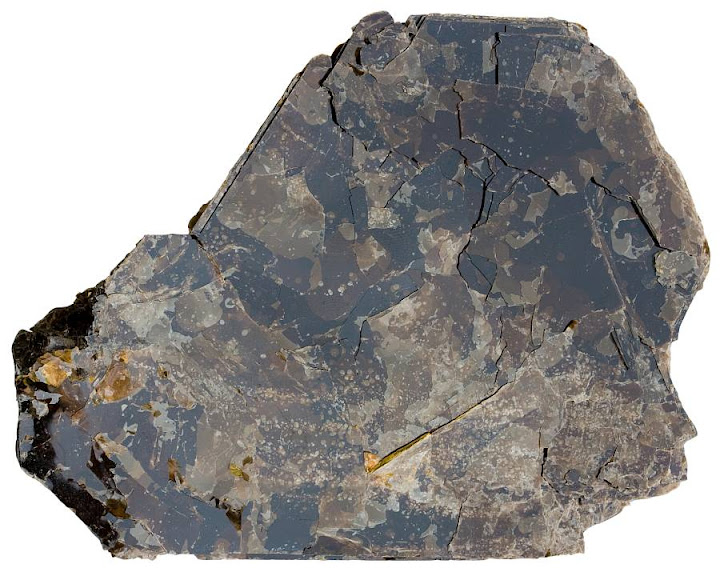
Biotite from granite pegmatite. Large mica samples come from pegmatitic rocks. Luumäki, Finland. Width of sample 13 cm.
Composition
A sample of the mineral with usual composition may be easily identifiable, but it is actually a mineral group because there are numerous possible replacements in the crystal lattice which gives rise to several end-members with different compositions. This is common for silicate minerals and especially widespread and complicated are the substitutions for sheet silicates. End-members such as phlogopite, annite and siderophyllite all belong to the group.
It is a common practice to distinguish between biotite and phlogopite like these two are mutually exclusive minerals with different compositions. This is no longer true. The term “biotite” has been discredited as a mineral species name by the International Mineralogical Association since 1999. It is now recommended that the term should be used for the entire series which includes phlogopite. However, phlogopite is often recognizably colored and has somewhat different occurrence which makes it logical to treat it separately from the other more iron-rich varieties.
Another interesting aspect that makes the use of the term necessary is that although there are several minerals in the mineral group, there are no clearly defined demarcation lines between them1. Therefore the naming may be confusing task even if the exact chemical composition is known.
There are four principal compositional end-members of the group:
K2Fe4Al2[Si4Al4O20](OH)4 – siderophyllite
K2Mg4Al2[Si4Al4O20](OH)4 – (eastonite)
K2Fe6[Si6Al2O20](OH)4 – annite
K2Mg6[Si6Al2O20](OH)4 – phlogopite
‘Eastonite’ is in parentheses because the term has been abandoned. Biotite close to eastonite end-member is rare in nature. Siderophyllite and annite are also more like a theoretical end-members because some of the iron in their crystal lattice is always substituted by magnesium. And in most cases some of the Fe/Mg of annite-phlogopite series is substituted by Al which moves them closer to the siderophyllite-(eastonite) series. Charge balance is maintained by replacing Al for Si in other site in the lattice (this substitution of multiple elements is known as the Tschermak’s substitution).
Biotite which is not phlogopite is therefore closer to annite or siderophyllite end-member. These so-called normal biotites tend to be black in color and they are sometimes referred to as lepidomelane (dark iron-rich biotite). Other possible replacements include F and Cl for OH and Na, Ca, Ba, Rb, Cs for K.

Dark iron-rich variety from granite pegmatite. Evje, Norway. Width of sample 11 cm.

Mg-rich variety phlogopite. Phlogopite has typically more brownish or fiery look than black iron-rich biotites. This rock (pure biotite-rock is known as glimmerite) formed similarly as part of pegmatite, but the source of fluids was mafic (gabbroic) magma which contained significantly more magnesium than felsic magma and favored the formation of phlogopite. Ødegården Verk, Norway. Width of sample 14 cm.
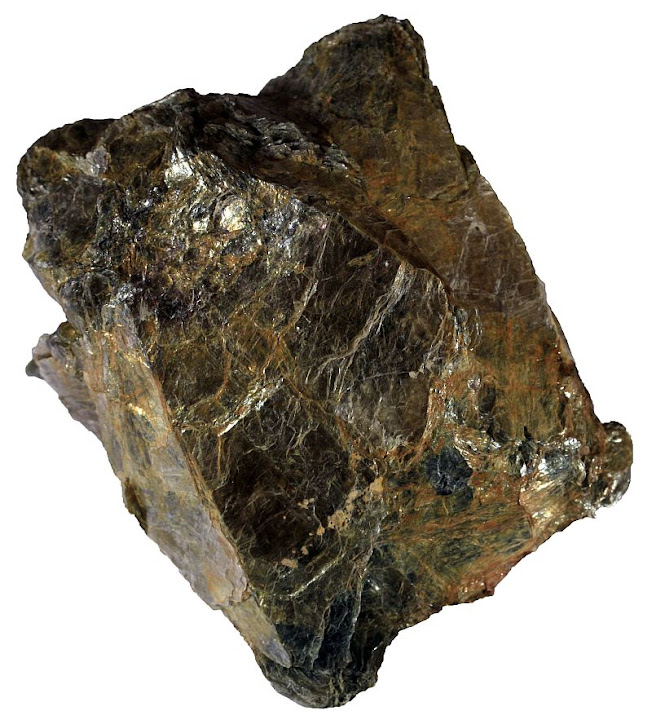
The three end-members already mentioned do not cover all the possible variations in composition. Zinnwaldite, for example, is compositionally close to iron-rich variety siderophyllite with added lithium. This mineral name, however, is also no longer in official use. The sample is from the type locality (Zinnwald) at the German/Czech border in The Ore Mountains. Width of sample 7 cm.
Properties and identification
The most characteristic property of these minerals is the perfect basal cleavage:

Mica minerals have perfect basal cleavage which makes it easy to separate them into many thin folia. Biotite (on the left) and muscovite are the most widespread micas.
Most biotite group minerals are black in color, although the color gets lighter (brownish) if the sheet is thin enough for the light to penetrate it. Mg-rich phlogopite is brown or greenish. The density is highly variable: 2.7-3.3 g/cm3. Iron-rich member annite is the heaviest.
Biotite is in most cases not difficult to identify. It is micaceous (composed of cleavable sheets). Muscovite has the same property, but it is usually much lighter in color. The micaceous character, however, may not be immediately obvious if the rock is fine-grained. Hornblende is a common amphibole mineral that may occur in very similar rocks (both are common in granitoids) and may look alike. In this case a needle is a handy tool that will quickly solve the question. These minerals are notably soft. Their hardness on the Mohs scale is only about 2.5-3 which is low for a silicate mineral (although within normal range for a sheet silicate). Biotite is easily scratched with a needle and you can also force it into the “book-like” aggregates of many layers. Nothing even remotely similar can be done to hornblende which is a much harder material. Phlogopite is usually more brownish or even fiery looking. That is why phlogopite is named so – phlogopos means ‘fiery looking’ in Greek.
Occurrence
It is among the most common and widespread minerals. It occurs in a wide variety of igneous rocks which includes both felsic and mafic rocks. It has different roles in these rocks, though. It acts as the primary iron-bearing phase in many granitic rocks and as a hydrated potassium-bearing mineral in mafic rocks. Biotite is present in both silica under- and oversaturated rocks. Biotite, because it is the host of relatively uncommon chemical elements in a given magma, is a very common ingredient of pegmatites which crystallize from late-magmatic fluids. Large “books” are a common sight in pegmatitic rocks. Biotite in felsic rocks tends to be Fe-rich.
Phlogopite in igneous rocks occurs in ultramafic rocks, especially diamond-bearing kimberlites. It is least common in mafic rocks, but these too host it sometimes. Especially if the magma is contaminated by the material from pelitic crustal rocks. It is much less frequent in volcanic rocks and generally absent in basalts (except some K-rich varieties). If present, biotite may be partially altered to other minerals. The reason why biotite is abundant in intrusive but usually resorbed in volcanic rocks is that it is not a stable phase in magma at lower pressures.
In metamorphic rocks too, biotite is present in a wide variety of rocks which formed under various temperature and pressure conditions. Biotite in the majority of cases forms when clay-rich sedimentary rocks are buried deep enough for the clay minerals to metamorphose to it. Biotite also forms in impure metamorphosed carbonate rocks and in metabasic rocks.
There are many different geochemical pathways that can lead to the formation of biotite which explains its ubiquitousness in metamorphic systems. It remains the companion of several metamorphic minerals (muscovite, garnet, staurolite, Al-silicates, cordierite) that inhabit pelitic rocks at various depths in the crust. Biotite finally disappears at the granulite facies conditions where hydrous minerals (which it is) are not stable. Metapelitic rocks that contain lots of biotite are various schists (biotite schist, biotite-chlorite schist, albite-biotite schist, garnet-mica schist).
In metamorphosed mafic rocks biotite forms as a replacement of low-grade greenschist facies metamorphic rocks containing amphiboles and muscovite. They react to form biotite + quartz + water. It finally breaks down to form granulitic rock composed of pyroxene + K-feldspars.
There are many reactions in impure carbonate rocks in which biotite (including phlogopite) can be among the reactants or products:
phlogopite + calcite + quartz → tremolite + K-feldspar + CO2 + H2O
dolomite + muscovite → biotite + chlorite + calcite + CO21
Biotite also occurs in skarns which are contact-metasomatized rocks which form when silicate magma reacts with carbonate rocks.
Biotite in clastic sediments is a common mineral when biotite-bearing rocks are exposed nearby. It is not as resistant in the weathering environment as muscovite and gets less frequent with extended transport. Biotite is usually altered to clay minerals montmorillonite and vermiculite.

Biotite and muscovite are the two most common mica minerals that often occur together in Al-rich igneous rock. Peraluminous two-mica granitoid. A fragment from an erratic on Alnö Island, Sweden. Width of sample 9 cm.

Monomineralic rock that is composed of (almost) pure biotite is known as glimmerite. It is usually part of a larger pegmatitic assemblage. Trælen, Senja, Norway. Width of sample 25 cm.

Tonalite pegmatite (white-gray on the right) and garnet amphibolite (on the left). Black in pegmatite is biotite, white is plagioclase, gray is quartz. Trælen, Senja, Norway. Width of sample 10 cm.
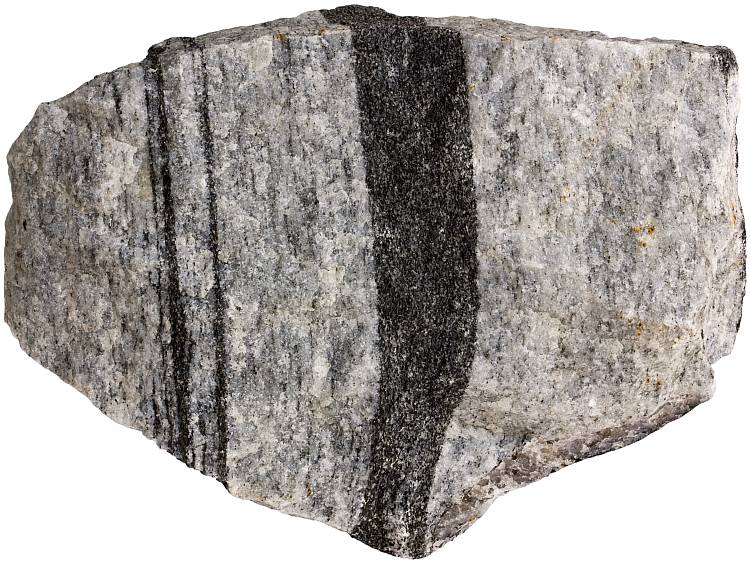
Biotite gneiss. Black mineral forming bands in the rock is biotite. White feldspar is plagioclase. Evje, Norway. Width of sample 14 cm.
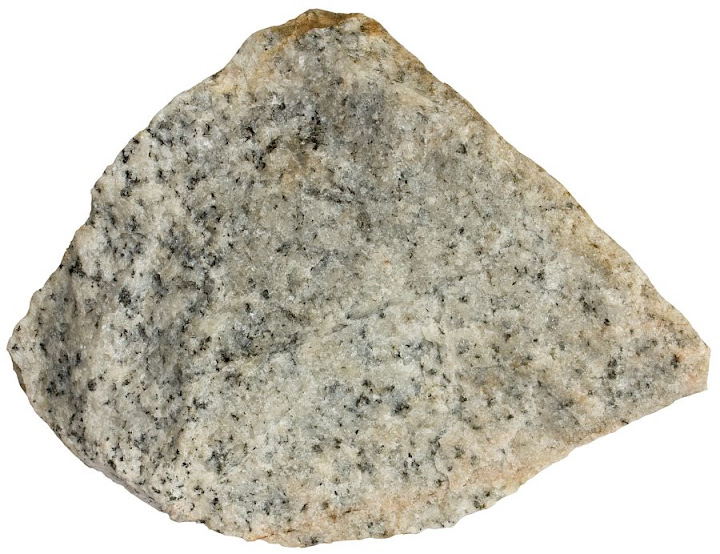
Trondhjemite is a leucocratic igneous rock (tonalite) in which the sole mafic mineral is biotite (hornblende is rare). Width of sample from Norway is 10 cm.
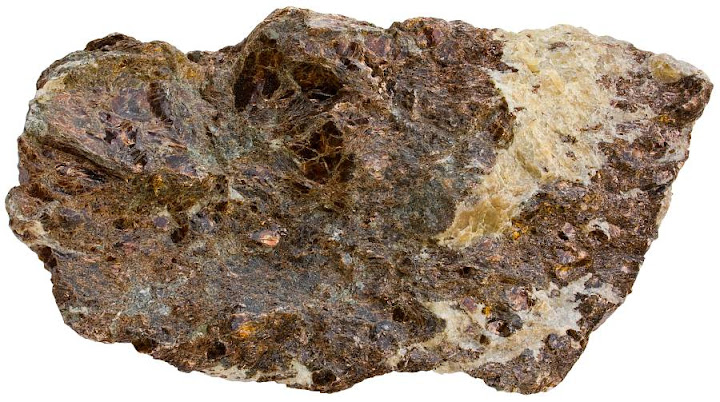
Phlogopite with apatite (greenish yellow) and enstatite (dark green) in pegmatite. Ødegården Verk, Norway. Width of sample 22 cm.

Nepheline syenite. Dark minerals are iron-rich biotite and pyroxene augite. Larvik, Norway. Width of sample 9 cm.
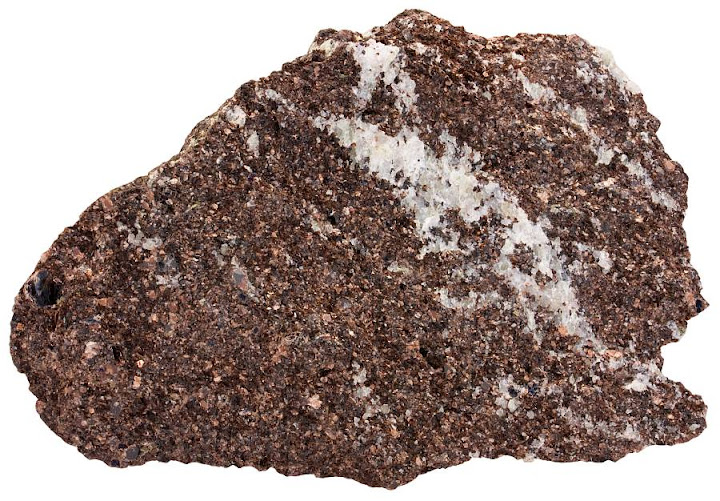
Phlogopite in glimmerite-carbonatite. Carbonatite is igneous rock with highly unusual carbonate composition (white mineral is calcite). It is usually phlogopite when biotite group mica is associated with carbonate minerals in igneous or metamorphic rocks. Siilinjärvi, Finland. Width of sample 9 cm.

Granite having slightly lineated texture. The mineral that gives it such an appearance is biotite. Note how the elongated patches are oriented sub-parallel to each-other. Lødingen, Norway. Width of sample 8 cm.
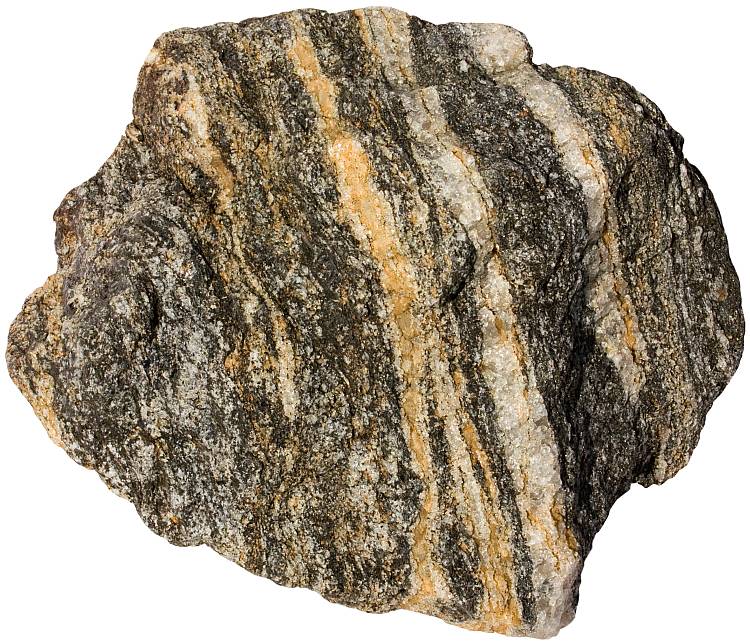
Biotite is a very common mineral in medium-grade metamorphic rock schist. Narvik, Norway. Width of sample 10 cm.
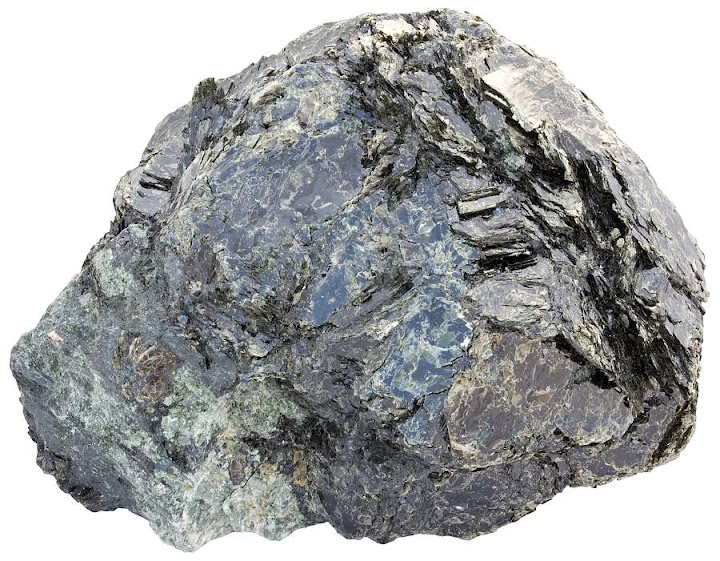
Biotite also occurs in metasomatic rocks. This skarn sample is composed of biotite with light green actinolite (Ca-Mg-amphibole). Hannukainen, Finland. Width of sample 9 cm.

Tonalite. Black biotite, white plagioclase, gray quartz. Kaatiala, Finland. Width of sample 10 cm.
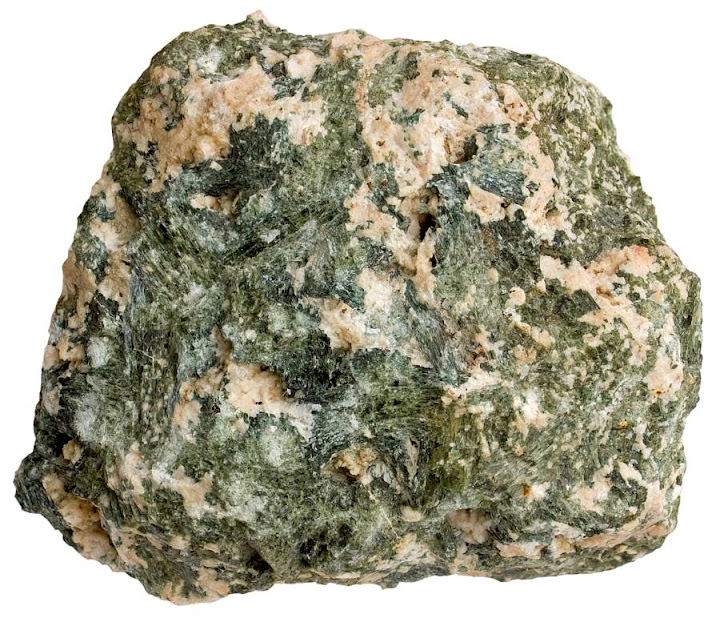
No biotite here. This rock is composed of alkali feldspar and amphibole of the tremolite-actinolite series. However, it is likely that phlogopite was here before the rock was altered to its current composition. Impure metamorphosed carbonate rocks that contain phlogopite, calcite and quartz can be metamorphosed to feldspar-tremolite rock: phlogopite + calcite + quartz → tremolite + K-feldspar + CO2 + H2O. Sample from Southern Norway. Width of sample 9 cm.

Biotite with garnet. Unusual pegmatite assemblage. Width of sample 13 cm. Senja, Norway.

Biotite and muscovite in sand. Micas are especially common in river sand because there they are closer to the source rocks. Biotite is not stable in the weathering environment. Width of view 20 mm.
Etymology
The mineral was named in honor of Jean Baptiste-Biot. Biot was a French scientist and as usual in the early 19th century contributed successfully in several fields of study. Although he is not considered to be a geologist, he is the one who claimed that meteorites are extraterrestrial in origin. To be correct, he was not the first one to say so, but the idea got much wider acceptance after that. He also studied materials in polarized light, including minerals. This is the reason why biotite was named in his honor by a German mineralogist Johann Friedrich Ludwig Hausmann in 1847. There are some claims that Biot discovered the mineral biotite. It can hardly be true. Biotite is a very common natural material which I am sure was well-known for our Stone Age ancestors. But he clearly contributed to a better understanding of the micas and deservedly has his family name (usually unintentionally) mentioned in every mineralogy and geology textbook.
Uses
Biotite itself is not very useful material. Mg-rich variety phlogopite is sometimes used as an insulator in electrical applications. But clay mineral vermiculite which forms as an alteration product (either weathering or hydrothermal) of iron-bearing varieties has several uses. Vermiculite is an expanding clay like smectite. It has water between the layers which is the reason why it expands greatly when heated. Heated vermiculite is a light-weight fluffed up material. It is used as a filler and insulating material in the construction industry. Vermiculite is also added to potting soil to improve its quality. Vermiculite enhances drainage and aeration because of low density and absorbs water to later slowly release it when the soil is drying up.
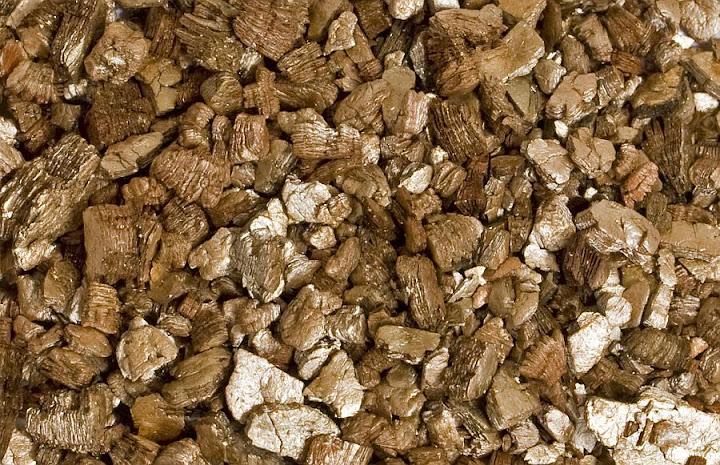
Vermiculite is an alteration product of biotite which expands greatly when heated (shown on the picture). Expanded vermiculite is a light-weight material well-suited for insulation and also used as a soil conditioner. Width of view 40 mm.
References
1. Deer, W. A., Howie, R. A. & Zussman, J. (1996). An Introduction to the Rock-Forming Minerals, 2nd Edition. Prentice Hall.
Leave a Reply